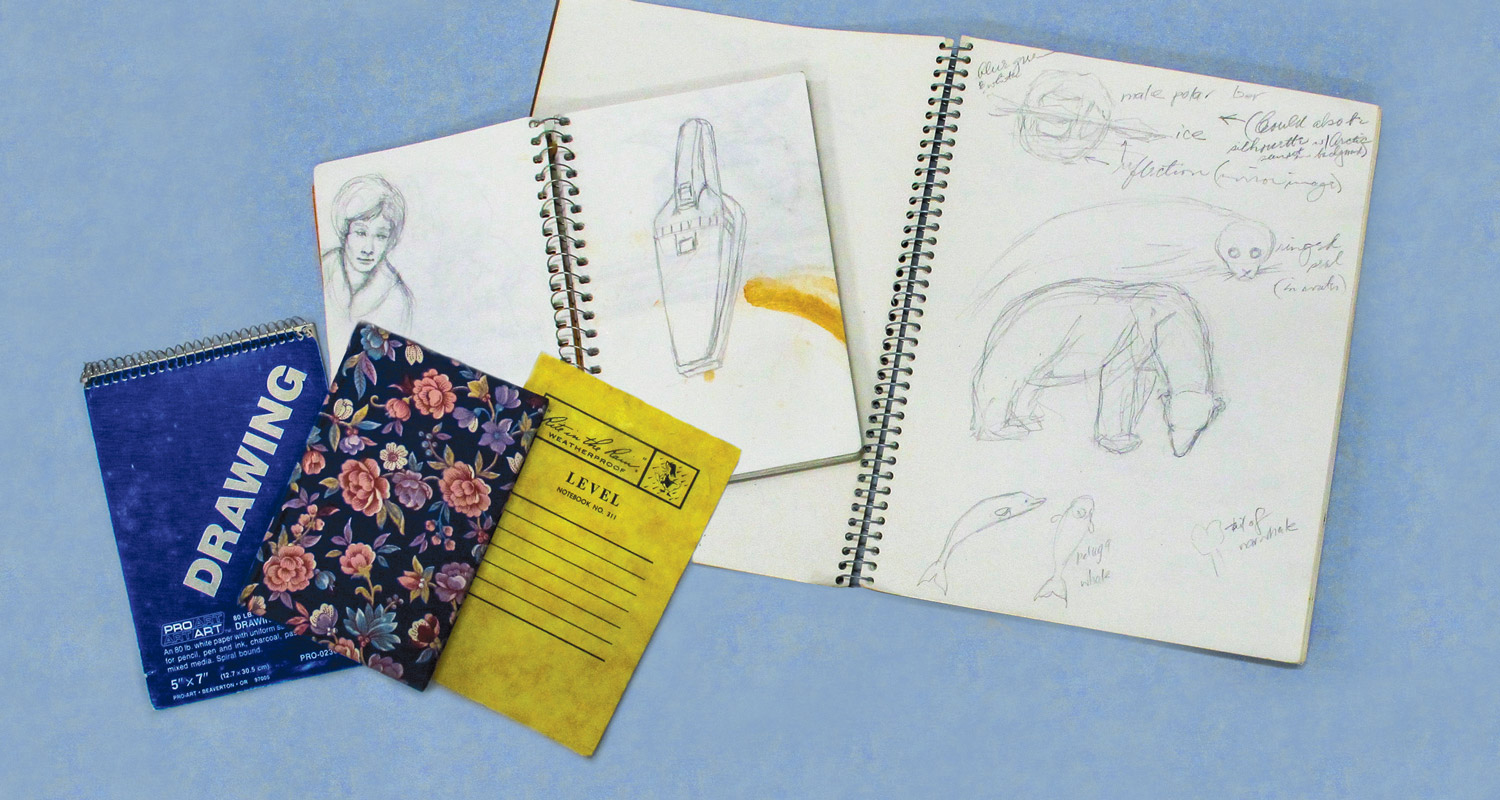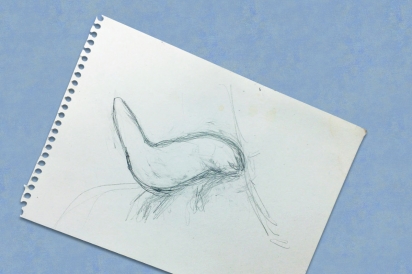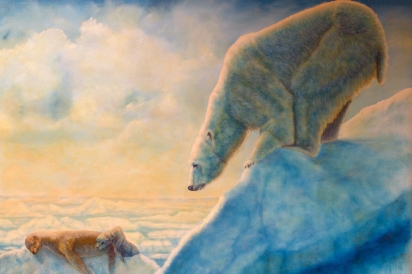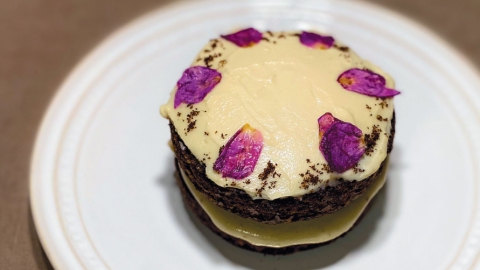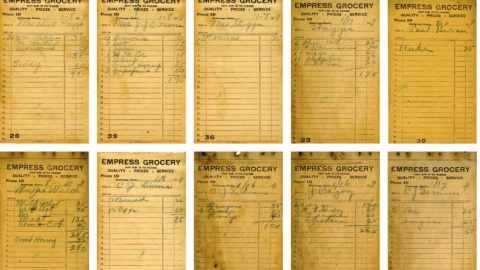The Art of Gathering
Celebrating Belle Dawson with Images (and Cake)
In Alaska, cupboards and pantries, root cellars and freezers are a kind of sketchbook of what we gather on summer ventures, collections assembled from gardens and harvest trips and stored up. Bags of blueberries, dried spruce tips and rose hips, jars of rich salmon, piles of sweet carrots and beets. In winter, Alaskans carefully portion these gatherings across the fallow months and assemble these treasured savings into hearty meals to warm spirits on cold nights.
The sketchbooks of artist Belle Dawson (1922-2011) in the Anchorage Museum archives reveal a particular attention to gathering Alaska in a similar, care-filled fashion. They serve as stores of ideas—images collected on adventures in the landscape and homegrown scenes, to be combined, used, and “cooked up” into future artworks. Dawson’s painterly work is characterized by animals, landscapes, and people gathered from her life experience, and then represented in realist renderings with a touch of romance.
Few detailed records exist about the life of Belle Dawson beyond a couple of newspaper clippings, a slim file of ephemera in museum archives, and the legacy of her artworks. She was born in Manhattan, New York and formally trained as an artist, earning a degree in Fine Arts from California State University, San Jose. She went on to receive a master’s in Library Science from the University of Denver, a degree which she used to become a travelling librarian, illustrator, and ambiguously described “arts and crafts director” with the U.S. Army and Air Force Special Services. One can imagine this job might have truly been one of gathering: collecting books and materials, art supplies, and documenting the places and peoples of her travels in illustration. After tours in Japan, Korea, and Prudhoe Bay, Dawson arrived at Loussac Library in 1972 to work as technical services director. This position is one of a gatherer as well: acquiring, cataloging, and preserving materials.
In this full life, Dawson kept pocket-sized sketchbooks which she took into the field (or living room) to gather ingredients for her artwork. In pages of graphite renderings are profiles of loved ones, Alaska flora and fauna, landscapes with notes about color, even a dust buster. Just like a cook pulling from pantry and cellar to put together a meal, Dawson raided her sketchbooks to craft her works. Her final paintings, as seen in Lunch Break (1978), take up images from her lived experience and reposition them into ideal, engaging compositions. While we cannot know if sketchbook pages of seal and polar bear were preparatory for Lunch Break, we can see her working out shape, understanding the form of the seal body on ice, which we see realized with simultaneous humor and tension, implied by the title of her final work.
For Dawson, the detailed and thoughtful portrayal of her subjects was part of a larger cause. She said of her practice, “My work is meant to be shared with the viewer and reflects my deep concern for the welfare of our ecological systems. I attempt to celebrate wildlife in its native habitat, and hope to communicate an awareness of the magnificent yet deceptively fragile beauty of the natural world.” Implicit in her visual feasts is appreciation, rather than overconsumption, of resources. Indeed, Dawson testified in 1977 in favor of HR 39, a bill that would ultimately lead to the passage of the Alaska National Interest Lands Conservation Act (ANILCA) in 1980. This bill protected 157 million acres—the single largest expansion of protected lands to date—while also, in Title VIII, granting all rural Alaskans priority subsistence rights on federal lands and waters. The expansion of the National Park Service and state and federal protection have implications for Alaska Native peoples who have sustainably stewarded Alaska’s lands for thousands of years, in some cases restricting access to needed food-stores and inhibiting traditional lifeways. The complexity around land management and sovereignty continues until this day.
Dawson also gathered with Anchorage’s still active square dance community on Friday evenings (eventually Friday and Saturday nights) for decades. Sarah Preskitt, Alaska Collection Librarian at the Anchorage Public Library, and daughter of Mike and Debbie Preskitt, grew up at these twice weekly square dances called by Mike, where Sarah had “40 sets of grandparents.” At these dances, food was and is a constant: cookies, crumbles, smoked salmon, an occasional congealed salad. Belle was a fixture at those dances from at least 1973. At no more than five feet tall, Belle was what Sarah described as a quiet presence, an “introvert’s introvert.” But just as in her art practice, she cared deeply for the community. As the dancers aged, she suggested to Mike Preskitt that he call the dances in slower time to allow everyone a more accessible experience. Her prolific art career was not something she touted to her fellow dancers. In fact, as Sarah relayed, she was unaware that Belle was an accomplished artist until close to Belle’s passing. “She was so very background,” Sarah says, “but her artwork just isn’t.” Truly, with works like Lunch Break, her work is lively, imaginative, and full of personality. Yet, she kept her various passions and communities discreet. As Sarah says, “She played her personal accomplishments close to the vest; I wish we could have celebrated her more in her lifetime.”
In one image in the Anchorage Museum collection, Dawson sits at a desk strewn with papers as someone hands her a large plate of what appears to be a quarter of a red velvet cake with candles for her 84th birthday. At least some folk have gathered—a photographer, the individual handing her the cake, but this does not look like a significant party, more like the attempt to celebrate an introvert’s introvert. Awkward surprise, delight, and humility seem evident on Belle’s face as she looks at a mountain of dessert—just for her.
Perhaps Dawson would not have wanted a gathering then, in 2006, but now 100 years after her birth, we can gather together a loose memoir of her life and work through her sketches, paintings, archival holdings, and shared remembrances. We can learn from her practice of gathering—collecting, storing up, and reassembling ingredients from lived experience into lively, compelling images that tell vibrant stories and share powerful values of care and community.
Perhaps, also, inspired by Belle Dawson, we can use winter ingredients at hand in our Alaskan cupboards—root vegetables, bean water, flour, some spices—to cook up a simple and simply decadent celebration, to have our cake and eat it, too.
Special thanks to Sarah Preskitt for her time and contribution sharing her knowledge of Belle. And to my neighbors on aptly named Dawson Street who served as recipe tasters, and ate lots of cake.


